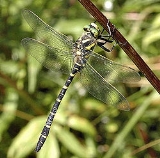
Golden-ringed Dragonfly
Encyclopedia
The Golden-ringed Dragonfly (Cordulegaster boltonii) is a large, striking dragonfly and the longest British species, the only one of its genus
to be found in Britain
.
in Britain
has.
 They are often seen flying leisurely over mountain streams or a river; they also occasional show up at a pond. They are also typically seen flying over heath land. Their bright yellow and black stripes make them easy to identify, even from a fair distance away. They feed mainly on insects ranging from small prey such as midges to flies, butterflies and even bumble bees. This strikingly-coloured insect is incredibly aerobatic and they sometimes fly very high up into the sky.
They are often seen flying leisurely over mountain streams or a river; they also occasional show up at a pond. They are also typically seen flying over heath land. Their bright yellow and black stripes make them easy to identify, even from a fair distance away. They feed mainly on insects ranging from small prey such as midges to flies, butterflies and even bumble bees. This strikingly-coloured insect is incredibly aerobatic and they sometimes fly very high up into the sky.
Genus
In biology, a genus is a low-level taxonomic rank used in the biological classification of living and fossil organisms, which is an example of definition by genus and differentia...
to be found in Britain
United Kingdom
The United Kingdom of Great Britain and Northern IrelandIn the United Kingdom and Dependencies, other languages have been officially recognised as legitimate autochthonous languages under the European Charter for Regional or Minority Languages...
.
Identification
They are easily identified by their distinctive black and yellow stripes, which no other dragonflyDragonfly
A dragonfly is a winged insect belonging to the order Odonata, the suborder Epiprocta or, in the strict sense, the infraorder Anisoptera . It is characterized by large multifaceted eyes, two pairs of strong transparent wings, and an elongated body...
in Britain
United Kingdom
The United Kingdom of Great Britain and Northern IrelandIn the United Kingdom and Dependencies, other languages have been officially recognised as legitimate autochthonous languages under the European Charter for Regional or Minority Languages...
has.
Larvae
The female lays the eggs in shallow water. The hairy larvae live at the bottom of the water and are well camouflaged amongst the silt. They emerge after about 2-5 years, and usually under the cover of darkness.Behaviour


